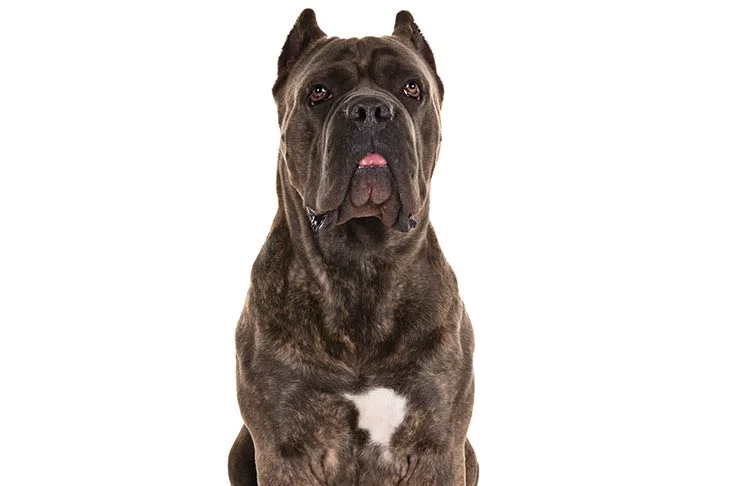A superior defender, the aggressive and self-assured Cane Corso is intelligent, trainable, and of noble bearing. The Corso’s lineage goes back to ancient Roman times, and the breed’s name roughly translates from the Latin as ‘bodyguard dog.’ At nearly 28 inches at the shoulder and often weighing more than 100 pounds, with a large head, alert expression, and muscles rippling beneath their short, stiff coat, Corsi are at a glance intimidating creatures. Their first line of protection against intruders is their intimidating appearance. ‘An understated aura of cool expertise, the kind of behavior you’d expect from a professional bodyguard, is the breed’s trademark,’ according to one writer. Corsi is highly intelligent, devoted, and ready to please their humans. However, they can also be pushy and willful and can find an unintentional owner. Responsible breeding and early socialization with people and other dogs are essential, just like with any other large guard dog.
Cane Corso
Average sizes and life
expectancy of the breed.
Height
25-27.5 inches (male)
23.5-26 inches (female)
Weight
Proportionate to height
Life Expectancy
9-12 years
Breed Traits & Characteristics
About the Breed

Owning a dog is not just a privilege; it’s a responsibility. They depend on us for, at minimum, food and shelter, and deserve much more. When you take a dog into your life, you need to understand the commitment that dog ownership entails.
 Health
Health
Large and deep-chested breeds are prone to bloat, a rapid, life-threatening stomach illness. Cane Corsos are typically healthy dogs, and responsible breeders examine their stock for health issues like hip dysplasia, idiopathic epilepsy, demodex mange, and eyelid anomalies. Owners of Cane Corso should get familiar with the warning signals and what to do if they appear. Like all breeds, Cane Corsos should have their ears periodically examined for indications of illness, and their teeth should be brushed frequently with dog-specific toothpaste.
Recommended Health Tests From the National Breed Club:
- Hip Evaluation
- Elbow Evaluation
- Cardiac Exam
 Grooming
Grooming
 Exercise
Exercise
 Training
Training
Early socialization and puppy training classes are recommended for all dogs, but for a breed as big and strong as a Cane Corso, they are a must. Many Cane Corsos can be dominant and protective; socialization will help ensure that they grow into well-adjusted, well-mannered adults. Obedience training will keep them from becoming the boss in the household. Cane Corsos are intelligent and eager to please, so they are generally easy to train. Despite their appearance, Cane Corsos are all heart and respond to love and rewards far better than to harsh corrections or training methods.
 Nutrition
Nutrition
History
With the dissolution of the Western Empire in the fifth century, Italy’s legions and their dogs were out of work. Corsi adapted to such civilian jobs as wild boar hunting, farming, livestock droving, and most famously, guarding farmsteads and henhouses. The Corso was for centuries a familiar sight on the farms and pastures dotting the Italian countryside. But the effects of constant invasions of the Italian peninsula and Sicily, economic and political upheavals, and mechanized farming conspired to reduce the Corso population to precariously low numbers. By the mid-20th century, the breed was all but extinct.
Italy’s legions and their dogs were out of a job when the Western Empire collapsed in the fifth century. Corsi became proficient at civilian occupations like farming, herding animals, hunting wild boar, and—most notably—guarding farmsteads and henhouses. For years, the Corso was a common sight on the fields and meadows that dot the Italian countryside. However, mechanical farming, frequent invasions of Sicily and the Italian peninsula, political and economic upheavals, and other factors combined to drastically lower the Corso population. The breed was all but extinct by the middle of the 20th century. Specimens did survive, however, in Italy’s back country. In the 1970s, a group of Italian fanciers banded together to revive the breed of their rustic ancestors. The Society Amorati Cane Corso (Society of Cane Corso Lovers) was formed in 1983, and by the following decade, Corsi was being exhibited in European dog shows.


